Here’s to a 2022 replete with long-delayed archaeological digs, museum exhibitions attended by record-breaking crowds and lots of history nerd-themed travel. And if circumstances continue to make such resolutions too hard to keep, then we’ll just have keep the nerdfires burning virtually right here. 😎
I hope your day was merry and bright
I could do without the white, though, truth be told. I shall return to my regularly scheduled programming tomorrow. 🙂
The eagle’s head made of Lincoln’s hair
In the collection of a small historical society in Syracuse, New York, is a 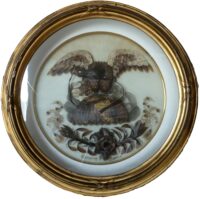 unique and seldom-seen object: an 1864 eagle on a globe made entirely of hair contributed by leading politicians and their wives, most notably President Abraham Lincoln and First Lady Mary Todd Lincoln.
unique and seldom-seen object: an 1864 eagle on a globe made entirely of hair contributed by leading politicians and their wives, most notably President Abraham Lincoln and First Lady Mary Todd Lincoln.
It was created for the Metropolitan Sanitary Fair, an exposition to benefit the United States Sanitary Commission, a private relief agency supporting the sick and wounded soldiers of the United States Army. Local women’s charitable groups affiliated with the USSC had successfully thrown fairs before in Chicago and Boston, and the Beneficent Ladies of New York followed suit in April of 1864. (These unapproved initiatives caused some consternation among the all-male Commissioners at USSC headquarters in Washington, but they could not deny the hundreds of thousands of dollars the fairs brought in.)
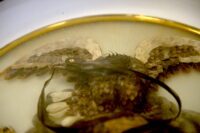 When the Metropolitan Fair was still early in the planning stages — the venue hadn’t even been determined yet — the committee appealed to individuals and businesses in New York and around the world for contributions of money and exhibits to entice visitors and raise funds for the cause. The expositions had pavilions showcasing all kinds of militaria, memorabilia, crafts and curiosities with heavy emphasis on Union patriotism linking the dramatis personae of the Civil War (Grant’s sword) and Revolutionary War heroes (Washington’s camp chest).
When the Metropolitan Fair was still early in the planning stages — the venue hadn’t even been determined yet — the committee appealed to individuals and businesses in New York and around the world for contributions of money and exhibits to entice visitors and raise funds for the cause. The expositions had pavilions showcasing all kinds of militaria, memorabilia, crafts and curiosities with heavy emphasis on Union patriotism linking the dramatis personae of the Civil War (Grant’s sword) and Revolutionary War heroes (Washington’s camp chest).
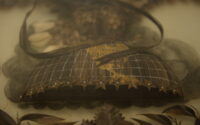 According to press accounts of the Fair, Mrs. Caroline Wright, wife of the former Governor of Indiana and Senator Joseph A. Wright, commissioned Brooklyn jewelers Spies & Champney to create a national symbol out of the hair of nationally-important politicians. The letter Spies & Champney sent to President Lincoln in January 1864 soliciting “as large a lock as you can well spare” is in the Library of Congress.
According to press accounts of the Fair, Mrs. Caroline Wright, wife of the former Governor of Indiana and Senator Joseph A. Wright, commissioned Brooklyn jewelers Spies & Champney to create a national symbol out of the hair of nationally-important politicians. The letter Spies & Champney sent to President Lincoln in January 1864 soliciting “as large a lock as you can well spare” is in the Library of Congress.
It’s pretty remarkable that from January they were able to receive locks of  hair from dozens of top politicians and their wives in time to weave such a large, intricate, detailed design which was completed and framed in time for exhibition at the Fair on April 4th. It hung on one of the piers of the Temple of Flora, the pavilion showcasing dramatic floral arrangements.
hair from dozens of top politicians and their wives in time to weave such a large, intricate, detailed design which was completed and framed in time for exhibition at the Fair on April 4th. It hung on one of the piers of the Temple of Flora, the pavilion showcasing dramatic floral arrangements.
“The Hairy Eagle” was singled out for praise in the New York Herald‘s account of the fair printed on opening day, April 4th, 1864, issue.
The curiosities in the Fair may be numbered by the thousand; but of all the strange and curious things, the hairy eagle is, without doubt, entitled to take the highest flight. It has winged its way from Indiana, having been donated to the Fair by Mrs. Governor Wright, of that State. It measures about twelve inches in length, and the head, eyes and back bone of this curious bird are formed of hair from the head of President Lincoln. The bill is formed of Secretary Chase’s hair, being symbolical of greenbacks and other bills. The wing feathers are made of hair from the heads of thirty-four prominent Senators, arranged in the order of their age. The tail and parts of the body are also of hair. Crowning this airy nothing is a wreath formed of the hair of the wives of representative men. It will be hung at the front of the pillar on the right of the Floral Temple, and underneath will be a small book, in which all admirers of President Lincoln will be allowed to enter their names on paying one dollar for the privilege of doing so. The money will go for the benefit of the Fair. The eagle, together with the book of autographs, will ultimately be presented to President Lincoln.
 Frank Leslie’s Illustrated Newspaper edition of April 23, 1864, sang the fair’s praises on the front page, and in a humorous take on the exhibits and visitors, recounted that the book had nothing like a thousand signatures yet. It also threw in a couple of burns on Secretary of the Navy Gideon Welles, the only cabinet member not to contribute hair as he “had none to spare,” and Senator Thaddeus Stevens of Pennsylvania who was “innocent of a single hair, and has sported a wig for the last 20 years.”
Frank Leslie’s Illustrated Newspaper edition of April 23, 1864, sang the fair’s praises on the front page, and in a humorous take on the exhibits and visitors, recounted that the book had nothing like a thousand signatures yet. It also threw in a couple of burns on Secretary of the Navy Gideon Welles, the only cabinet member not to contribute hair as he “had none to spare,” and Senator Thaddeus Stevens of Pennsylvania who was “innocent of a single hair, and has sported a wig for the last 20 years.”
Whether the goal of $1000 and 1000 signatures was met is unknown, but the report of the fair compiled three years later noted that the book was so popular 400 signatures and $400 were collected within the first three days of the Fair. We do know the Hairy Eagle was never presented to Mrs. 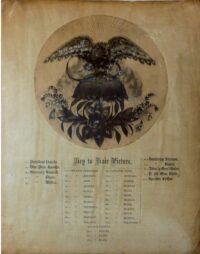 Lincoln or the President. Instead, it hung in the window of the Champney & Smitten shop in Brooklyn for many years. It moved upstate in the 19teens with Francis Champney’s wife Ida. After his death, she moved to Syracuse to live with their daughter Mrs. Sarah Wanamaker. The family donated the Hairy Eagle to the Onondaga Historical Association some time before 1917. With the weaving she donated a key that maps and lists all the different hair contributors.
Lincoln or the President. Instead, it hung in the window of the Champney & Smitten shop in Brooklyn for many years. It moved upstate in the 19teens with Francis Champney’s wife Ida. After his death, she moved to Syracuse to live with their daughter Mrs. Sarah Wanamaker. The family donated the Hairy Eagle to the Onondaga Historical Association some time before 1917. With the weaving she donated a key that maps and lists all the different hair contributors.
No OHA records of the acquisition survive, but one undated newspaper clipping in the OHA archives calls Ida’s gift “both historic and extremely artistic,” adding, “There is no better specimen of patience and wonderful intricate weaving.”
According to OHA curator Thomas H. Hunter, the wreath has never been loaned out to another organization. A man alleging to own an article of Lincoln’s bloodstained clothing once requested to remove some of the president’s hair from the sculpture for a DNA test, but as Hunter recalls with a droll smile, “I said, ‘No, we’re not going to do that.'”
Encased in a wood frame covered with convex glass, the Hairy Eagle’s reverse is covered with plaster of Paris. “Basically, it’s hermetically sealed; there’s never been any examination of [the wreath],” Hunter says. “If it were opened now, the deterioration process would be exponentially accelerated. … I would never want to chance that.”
The OHA only displays the Hairy Eagle only on rare special occasions to keep it out of the light as much as possible. The last time it was exhibited was February 2019 to celebrate the 210th anniversary of Lincoln’s birth.
House of the Muses to open to the public
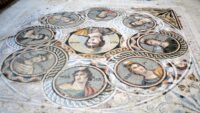 The House of the Muses, a Roman imperial-era domus decorated with elaborate mosaics and wall paintings, in the ancient city of Zeugma in southeastern Turkey’s Gaziantep province, will open to the public for the first time since it was discovered in 2007.
The House of the Muses, a Roman imperial-era domus decorated with elaborate mosaics and wall paintings, in the ancient city of Zeugma in southeastern Turkey’s Gaziantep province, will open to the public for the first time since it was discovered in 2007.
Built in the late 1st century, the villa was expanded and redecorated in the late 2nd, early 3rd century. It was destroyed by the invading Sassanids who sacked the city in 252/3 A.D., but its spectacular mosaic floors from the villa’s later period survived in excellent condition under the rubble fill. The house is named for perhaps the most specular of the mosaics: circular portraits of the Nine Museums bordered with geometric spirals and waves. Calliope, muse of epic poetry, is in the center circle.
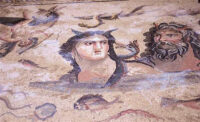 Another floor mosaic found in 2014 depicts the Titan Oceanus, the divine personification of the world-encircling river, and his sister/wife Tethys, mother of all the river gods. They both have wings sprouting from their foreheads, traditional attributes of the sibling spouses, and she bears a ketos, a dragon-headed snake, on her shoulder. Relatively rare in Greek iconography, the couple became a popular motif in the eastern Greek provinces of the Roman Empire between the 2nd and 4th centuries. In Zeugma, they appear in mosaics of luxury homes as symbols of marriage. The muses were also associated with marriage, as according to mythology they descended from Olympus to dance and sing at marriages of divinities/heroes like Cadmus and Harmonia and Peleus and Thetis.
Another floor mosaic found in 2014 depicts the Titan Oceanus, the divine personification of the world-encircling river, and his sister/wife Tethys, mother of all the river gods. They both have wings sprouting from their foreheads, traditional attributes of the sibling spouses, and she bears a ketos, a dragon-headed snake, on her shoulder. Relatively rare in Greek iconography, the couple became a popular motif in the eastern Greek provinces of the Roman Empire between the 2nd and 4th centuries. In Zeugma, they appear in mosaics of luxury homes as symbols of marriage. The muses were also associated with marriage, as according to mythology they descended from Olympus to dance and sing at marriages of divinities/heroes like Cadmus and Harmonia and Peleus and Thetis.
Earlier this year archaeologists revealed they’d found two symmetrical rock-cut chambers under 16 meters (52 feet) of fill. Flanking the east and west sides of the central courtyard, the chambers are hypothesized to have been dining rooms used to create an indoor-outdoor space for guests during all seasons.
Stating that the ancient city of Zeugma was one of the most important cities in Anatolia, especially on the Eastern Roman border, [excavation leader Professor Kutalmış] Görkay said that the excavations in the House of Muses, which have been ongoing since 2007, provided important information about the private lives, personal preferences and identities of the inhabitants of Zeugma.
“When we look at the places and the general structure of the house, we think that Zeugma belonged to a family having better than the middle-class economy. These houses may have one or two courtyards. Courtyards are areas where air and water enter, where rainwater is collected and used as water collection basins. In these wet areas, we see more water-related scenes. The courtyards of these houses were also used for dinner parties. The courtyards were filled with water, helping the house to stay cool during hot weather. The two rock chambers found here may also have been used as dining rooms. We are currently working on reinforcement. We aim to open them to visitors as soon as possible,” he said.
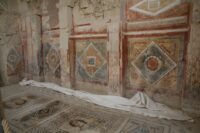 Much of the ancient town was flooded when the Birecik Dam was built over the Euphrates in 2000. Out of the estimated 2,000-3,000 ancient houses in Zeugma, 25 are fully submerged now, and archaeological excavations have barely scratched the surface of what remains. The House of the Museums will be an important addition to Zeugma’s heritage attractions which feature the largest mosaic museum in the world with more than 18,000 square feet of mosaics salvaged from the city.
Much of the ancient town was flooded when the Birecik Dam was built over the Euphrates in 2000. Out of the estimated 2,000-3,000 ancient houses in Zeugma, 25 are fully submerged now, and archaeological excavations have barely scratched the surface of what remains. The House of the Museums will be an important addition to Zeugma’s heritage attractions which feature the largest mosaic museum in the world with more than 18,000 square feet of mosaics salvaged from the city.
Roman tomb stele found in ancient Parion
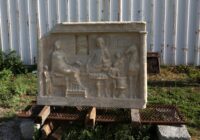 A carved funerary stele dating to the 1st century has been unearthed in the ancient Greek city of Parion, Kemer Village, in northwestern Turkey’s Çanakkale province. It was discovered in the town’s southern necropolis in an area which had been damaged by mechanical diggers during construction of a primary school in 2004. Many of the graves were damaged in the process, but the stele and burial chamber of Tomb 6 were found in comparatively good condition covered with five large stones.
A carved funerary stele dating to the 1st century has been unearthed in the ancient Greek city of Parion, Kemer Village, in northwestern Turkey’s Çanakkale province. It was discovered in the town’s southern necropolis in an area which had been damaged by mechanical diggers during construction of a primary school in 2004. Many of the graves were damaged in the process, but the stele and burial chamber of Tomb 6 were found in comparatively good condition covered with five large stones.
The stele is approximately three feet square and features a funerary banquet scene set inside an architectural border of fluted columns left and right. To the left is a seated female figure attended by a female servant (disproportionately small to distinguish attendants from their masters). Above her to the left is a calathus, a basket type used to hold skeins of wool or bring in the fruit harvest that was associated with women, marriage and fertility.
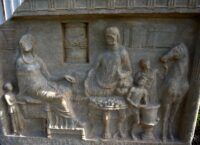 The central figure is a reclining man. Before him is a sturdy mensa Delphica, a tripod table with legs carved to look like animal legs. The table is heavy with fruit. To his right are two servants, one serving a beverage from a large krater, one groom with, presumably, the master’s horse. Above the servants to the right are a chest and box, representing the household’s wealth.
The central figure is a reclining man. Before him is a sturdy mensa Delphica, a tripod table with legs carved to look like animal legs. The table is heavy with fruit. To his right are two servants, one serving a beverage from a large krater, one groom with, presumably, the master’s horse. Above the servants to the right are a chest and box, representing the household’s wealth.
A Latin inscription on the bottom of the stele identifies the couple in the relief: “Lucius Furnius Lesbonax, who was freed by Lucius, had this burial stele built for himself and his wife, Furnia Sympnerusa.”
Four burials containing the remains of 10 individuals were discovered around Tomb 6. One was a child, the other nine were adults. Each individual was buried with their own separate grave goods.
Pointing out that the stele is a significant find, [excavation leader Professor Vedat] Keleş said: “This stele showed us that the southern necropolis of Parion was heavily used during the Roman and earlier periods. At the same time, when we look at the condition of the tomb stele and the city, it shows us that the ancient city was a rich one in the Roman period, as it was a colonial city.”
“The names on the stele are also very important. For instance, Lesbonax is not a Latin name. His wife’s name is also not a Latin name. These are Greek names. We can even say that Lesbonax was someone who lived on the island of Lesbos. We understood that they were slaves and were later given Roman citizenship. We understood that when the Romans came to this city, they enslaved those who were here and then gave them citizenship,” he added.